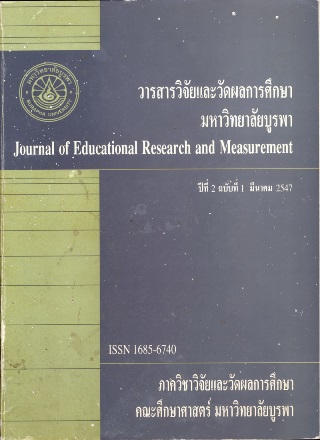การพัฒนาโมเดลความสัมพันธ์เชิงสาเหตุการปรับตัวของผูติดเชื้อเอชไอวี
Main Article Content
Abstract
การวิจัยครั้งนี้มีวัตถุประสงคเพื่อพัฒนาและตรวจสอบโมเดลความสัมพันธเชิงสาเหตุการปรับตัวของผู ติดเชื้อเอชไอวีตามทฤษฎีการปรับตัวของรอย (Roy, 1984) กลุมตัวอยางที่ศึกษา ไดแก ผูติดเชื้อเอชไอวีที่เปน สมาชิกชมรมเพื่อนวันพุธ ศูนยวิจัยโรคเอดส สภากาชาดไทย ปพ.ศ. 2545 จํานวน 400 คน ตัวแปรที่ศึกษา ประกอบดวย ตัวแปรแฝง 6 ตัวแปร ไดแกการเปดเผยสภาพการติดเชื้อ ความเขมแข็งอดทน การสนับสนุนทาง สังคม ความเชื่ออํานาจภายในตนดานสุขภาพ การรับรูที่เปนตราบาป และการปรับตัว เครื่องมือที่ใชในการวิจัย ไดแก แบบวัดความเขมแข็งอดทน แบบวัดการสนับสนุนทางสังคม แบบวัดความเชื่ออํานาจภายในตนดาน สุขภาพ แบบวัดการรับรูที่เปนตราบาป และแบบวัดการปรับตัว การวิเคราะหขอมูลใชโปรแกรม SPSS หา คาสถิติพื้นฐาน และใชโปรแกรม LISREL 8.50 วิเคราะหโมเดลความสัมพันธเชิงสาเหตุ ผลการวิจัยพบวา โมเดลความสัมพันธเชิงสาเหตุการปรับตัวของผูติดเชื้อเอชไอวีที่ปรับแลวมีความ สอดคลองกับขอมูลเชิงประจักษโดยพิจารณาจากคาไค-สแควรเทากับ 52.98 ที่องศาอิสระเทากับ 120 คาความ นาจะเปน เทากับ 1.00 ดัชนี GFI เทากับ 0.99 ดัชนี AGFI เทากับ 0.97 ดัชนี CFI เทากับ 1.00 คา Standardized RMR เทากับ 0.02 และคา RMSEA เทากับ 0.00 ตัวแปรทั้งหมดในโมเดลสามารถอธิบาย ความแปรปรวนในตัวแปรการปรับตัวไดรอยละ 72 ตัวแปรที่มีอิทธิพลทางตรงตอการปรับตัวอยางมีนัยสําคัญ ทางสถิติไดแกความเขมแข็งอดทน ความเชื่ออํานาจภายในตนดานสุขภาพ ระยะเวลาการติดเชื้อและอายุ
DEVELOPMENT OF A CAUSAL RELATIONSHIP MODEL FOR INFECTED HIV ADAPTATION
The purpose of this research was to develop and validate a causal relationship model of infected HIV adaptation, based on adaptation theory of Roy (1984). Samples consisted of 400 infected HIVs who were members of the Wednesday Friend Club, the Thai Red Cross, and the AIDS Research Center in the year 2002. The model consisted of six latent variables: disclosure of HIV infection, hardiness, social support, internal health locus of control, stigma perception, and adaptation. The research instruments included the Hardiness Scale, Social Support Scale, Internal Health Locus of Control Scale, Stigma Perception Scale, and Adaptation Scale. Descriptive statistics were derived by using SPSS, and the quality of the causal relationship model was assessed by applying LISREL 8.50. Results indicated that the adjusted model was consistent with empirical data. The validation of the model was indicated by chi-square test of goodness of fit equal to 52.98 with 120 degrees of freedom, p = 1.00. LISREL’s goodness of fit index, GFI, was 0.99; the adjusted goodness of fit index, AGFI, was 0.97; the comparative fit index, CFI, was 1.00; the standardized root mean square residual (RMR), was 0.02, with RMSEA, the root mean square error of approximation, found to be 0.00. The variables in the model accounted for 72 percent of the variance of adaptation. The variables that had statistically significant direct effects on adaptation were hardiness, internal health locus of control, duration of HIV infection, and age.

